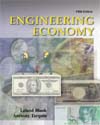

 Engineering Economy, 5/e Benefit/Cost Analysis and Public Sector Economics Chapter Review: True or False Quiz |
 2002 McGraw-Hill Higher Education
2002 McGraw-Hill Higher EducationAny use is subject to the Terms of Use and Privacy Policy.
McGraw-Hill Higher Education is one of the many fine businesses of The McGraw-Hill Companies.